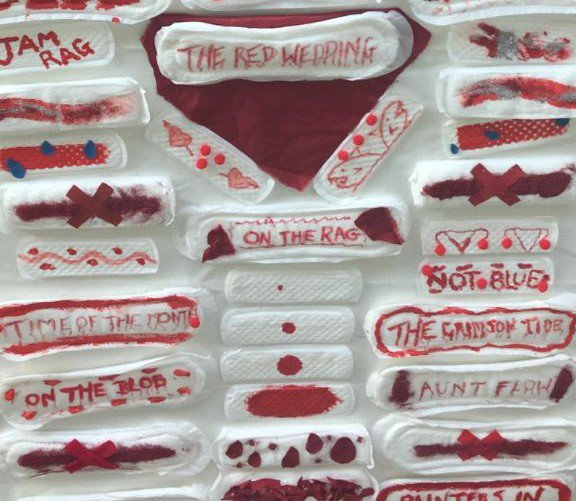How cultural attitudes to menstruation have finally started to shift
by Dr Kay Standing and Bee Hughes
28 May 2019
This blog post is part of our Summer Showcase series, celebrating our free festival of ideas for curious minds.
Cultures around the world share a stigma around menstruation. The results of this manifest in a variety of different forms; including period poverty in the UK and different exclusionary and discriminatory practices happening globally to this day. There is a growing body of work on addressing menstrual stigma inside and outside academic research, with global activist communities increasing debate in the public and political realms. Over the last few decades, radical menstrual activism has opened up global conversations that challenge the dominant cultural narrative of menstruation as something that is ‘shameful’, and ‘dirty’, aiming to make it visible and to recognise the differing individual experiences of people who menstruate. While it is important to highlight the issues that those who menstruate face, focusing on stigma and taboos can be counter-productive. By continuing to repeat these negative ideas, we risk reinforcing the very stigmas and exclusionary practices that organisations, researchers and activists are trying to challenge.

Advertising, activism and visual culture
Our cultural narratives around menstruation are reflected and reaffirmed by the way periods have been presented in film, TV and popular books, and through advertising campaigns from the menstrual product industry. Researchers of the visual culture of menstruation have written about how advertising has, in recent years, co-opted the messages and styles of feminist activism and art to produce adverts that reflect our shifting cultural attitudes to menstruation. While this is a recognition of the gradual moves away from stigma, it is also clear that there is a long way to go until commercial advertising really catches up with the advances towards menstrual equity.
Advertising plays a big role in young people’s understanding of menstruation and of the products available. The first TV advert in the UK to depict red-coloured menstrual blood wasn’t aired until 2017, receiving much critical acclaim, but also much backlash. Multinationals such as Procter and Gamble (which owns brands including Always and Tampax) make 28% of their net sales from ‘baby, feminine and family care’. Chella Quint has examined the role of advertising in perpetuating and profiting from menstrual stigma and concealment in her comedy show and zine series Adventures in Menstruating.
Menstrual activism has a long history in the women’s health movement, feminism and more recently anarchist and environmental movements. Feminist artists have often pushed the envelope in finding new ways to present more realistic images of the menstrual cycle and menstrual bleeding than the sanitised and stylised images we are used to seeing in everyday life. In 1970s USA, Gloria Steinem wrote the satire If Men Could Menstruate and radical feminist artists such as Judy Chicago made works like Red Flag (1971), a photolithograph of the removal of a bloodied tampon from a vagina, both challenging and subverting cultural attitudes to menstruation. Following in this tradition, Bee Hughes’ menstrual artwork is informed by examining the language of online medical advice, directly and publicly challenging to the stigma of menstruation, as well as the notion that all periods conform to the medical textbooks.
Growing global campaigns
In the late 1970s, the Toxic Shock Syndrome crisis, exacerbated by the Procter & Gamble superabsorbent Rely tampons (withdrawn from the US market in 1980) spurred a new wave of menstrual activism. In the UK, environmental activists including Bernadette Vallely founded the Women’s Environmental Network (WEN) to challenge a lack of transparency and accountability in the commercial product industry, and the polluting and environmentally harmful methods used by manufacturers.
More recently, there has been a global turning point in how menstruation is discussed. Cosmopolitan called 2015 the year the period went public, with a combination of academic research, grassroots activism and social media leading to commentators arguing menstruation is now ‘having a moment’. In that year, Kiran Ghandhi demonstrated free bleeding in the London marathon, Rupi Kaur’s Instagram image of her everyday menstrual bleeding was removed and reinstated, many ongoing campaigns against tampon tax gained momentum and Amika George’s Free Periods campaign launched in the UK.
These activities highlighted stigma around both menstruation and more specifically, period poverty, or being unable to afford menstrual products – a worldwide problem that has become a major focus of campaigns in numerous countries. A 2017 survey found that one in ten women aged 14 to 21 in Britain were affected. In 2018, Scotland pledged to provide free menstrual products in schools, universities and colleges, with England set to follow in 2020.
International organisations such as Water Aid, Plan International, and UNICEF are working on menstrual hygiene management programmes globally to provide education, access to toilets, facilities and products, and to recognise menstruation as part of wider issues of gender equality and human rights. It is also vitally important that initiatives to end period poverty do not end up lining the pockets of the menstrual product industry. As Chris Bobel argues, “the menstrual revolution won’t be meaningful if all we end up with are better products in hands that already have them and commercial products in the hands of those who currently use rags. What we need much, much more is an attitudinal shift.” There is also growing concern around the amount of plastic waste generated by disposable pads and tampons, with more and more emphasis on making reusable solutions accessible.
Activism and education are an important global movement. Dignity Without Danger is a British Academy and GCRF-funded project on the origins of menstrual beliefs and practices, which explores the diverse range of beliefs, practices and historical and cultural roots that underpin menstrual health customs in all seven provinces of Nepal. The practice of chhaupadi and menstrual exclusion dominates media coverage, but there is no single all-encompassing narrative on menstruation in Nepal. We are working with a range of activists and organisations to change the one-dimensional representation of menstruation and menstrual stigma.
Changing language and changing perceptions
The language we use also matters, and the way we talk about periods has been hugely influenced by medicine, advertising and traditional ideas about femininity. The work of academics such as Chris Bobel and Breanne Fahs and activists like Cass Clemmer has encouraged a change in the language used to talk about menstruation, to be more inclusive of the experiences of trans* and/or non-binary menstruators. Language is also important in challenging stigma; terms such as ‘sanitary’ and ‘hygiene’ imply menstruation is something which is unclean (despite the fact that the vagina is self-cleaning) and can reinforce the negative light in which menstruating bodies are often seen.
Our research explores the origins of our cultural attitudes to menstruation and how they are shaped by medicine and media representations that perpetuate the cycle of secrecy and misinformation contributing to the stigmatisation of menstruation. Through art, activism and education, our work suggests ways to challenge and change these prevailing negative associations and to create new and transgressive representations.
Dr Kay Standing is Reader in Gender Studies and Lecturer at Liverpool John Moores University. Her project was funded by a BA / Leverhulme Small Research Grant in 2016.
Bee Hughes is a PhD candidate in Media, Culture & Communication at Liverpool John Moores University.



